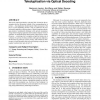Free Online Productivity Tools
i2Speak
i2Symbol
i2OCR
iTex2Img
iWeb2Print
iWeb2Shot
i2Type
iPdf2Split
iPdf2Merge
i2Bopomofo
i2Arabic
i2Style
i2Image
i2PDF
iLatex2Rtf
Sci2ools
CCS
2008
ACM
2008
ACM
Reconsidering physical key secrecy: teleduplication via optical decoding
The access control provided by a physical lock is based on the assumption that the information content of the corresponding key is private -- that duplication should require either possession of the key or a priori knowledge of how it was cut. However, the everincreasing capabilities and prevalence of digital imaging technologies present a fundamental challenge to this privacy assumption. Using modest imaging equipment and standard computer vision algorithms, we demonstrate the effectiveness of physical key teleduplication -- extracting a key's complete and precise bitting code at a distance via optical decoding and then cutting precise duplicates. We describe our prototype system, Sneakey, and evaluate its effectiveness, in both laboratory and real-world settings, using the most popular residential key types in the U.S. Categories and Subject Descriptors I.4.7 [Image Processing and Computer Vision]: Feature Measurement General Terms Experimentation, Measurement, Security Keyword...
| Added | 12 Oct 2010 |
| Updated | 12 Oct 2010 |
| Type | Conference |
| Year | 2008 |
| Where | CCS |
| Authors | Benjamin Laxton, Kai Wang, Stefan Savage |
Comments (0)

